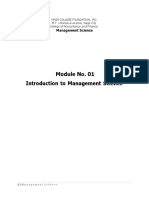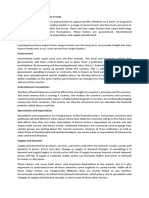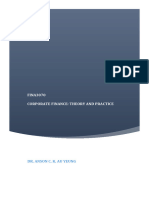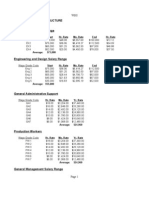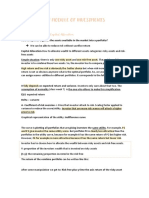Binomial Trees: Practice Questions
Binomial Trees: Practice Questions
Uploaded by
Hana LeeCopyright:
Available Formats
Binomial Trees: Practice Questions
Binomial Trees: Practice Questions
Uploaded by
Hana LeeOriginal Title
Copyright
Available Formats
Share this document
Did you find this document useful?
Is this content inappropriate?
Copyright:
Available Formats
Binomial Trees: Practice Questions
Binomial Trees: Practice Questions
Uploaded by
Hana LeeCopyright:
Available Formats
CHAPTER 12 Binomial Trees
Practice Questions
Problem 12.1. A stock price is currently $40. It is known that at the end of one month it will be either $42 or $38. The risk-free interest rate is 8% per annum with continuous compounding. What is the value of a one-month European call option with a strike price of $39? Consider a portfolio consisting of 1 : Call option + : Shares If the stock price rises to $42, the portfolio is worth 42 3 . If the stock price falls to $38, it is worth 38 . These are the same when 42 3 = 38 or = 0.75 . The value of the portfolio in one month is 28.5 for both stock prices. Its value today must be the present value of 28.5, or 28.5e0.080.08333 = 28.31. This means that f + 40 = 28.31 where f is the call price. Because = 0.75 , the call price is 40 0.75 28.31 = $1.69 . As an alternative approach, we can calculate the probability, p , of an up movement in a risk-neutral world. This must satisfy: 42 p + 38(1 p) = 40e0.080.08333 so that 4 p = 40e0.080.08333 38 or p = 0.5669 . The value of the option is then its expected payoff discounted at the riskfree rate: [3 0.5669 + 0 0.4331]e0.080.08333 = 1.69 or $1.69. This agrees with the previous calculation. Problem 12.4. A stock price is currently $50. It is known that at the end of six months it will be either $45 or $55. The risk-free interest rate is 10% per annum with continuous compounding. What is the value of a six-month European put option with a strike price of $50? Consider a portfolio consisting of 1 : Put option + : Shares If the stock price rises to $55, this is worth 55 . If the stock price falls to $45, the portfolio is worth 45 5 . These are the same when 45 5 = 55 or = 0.50 . The value of the portfolio in six months is 27.5 for both stock prices. Its value today must be the present value of 27.5 , or 27.5e0.10.5 = 26.16 . This means
that
f + 50 = 26.16 where f is the put price. Because = 0.50 , the put price is $1.16. As an alternative approach we can calculate the probability, p , of an up movement in a risk-neutral world. This must satisfy: 55 p + 45(1 p) = 50e0.10.5 so that 10 p = 50e0.10.5 45 or p = 0.7564 . The value of the option is then its expected payoff discounted at the riskfree rate: [0 0.7564 + 5 0.2436]e0.10.5 = 1.16 or $1.16. This agrees with the previous calculation.
Problem 12.9. A stock price is currently $50. It is known that at the end of two months it will be either $53 or $48. The risk-free interest rate is 10% per annum with continuous compounding. What is the value of a two-month European call option with a strikeprice of $49? Use noarbitrage arguments. At the end of two months the value of the option will be either $4 (if the stock price is $53) or $0 (if the stock price is $48). Consider a portfolio consisting of: + : shares
1 : option The value of the portfolio is either 48 or 53 4 in two months. If 48 = 53 4 i.e., = 0.8 the value of the portfolio is certain to be 38.4. For this value of the portfolio is therefore riskless. The current value of the portfolio is: 0.8 50 f where f is the value of the option. Since the portfolio must earn the risk-free rate of interest (0.8 50 f )e0.102/12 = 38.4 i.e., f = 2.23 The value of the option is therefore $2.23. This can also be calculated directly from equations (12.2) and (12.3). u = 1.06 , d = 0.96 so that e0.102/12 0.96 p= = 0.5681 1.06 0.96 and f = e0.102/12 0.5681 4 = 2.23
Problem 12.13. For the situation considered in Problem 12.12, what is the value of a six-month European put option with a strike price of $51? Verify that the European call and European put prices satisfy putcall parity. If the put option were American, would it ever be optimal to exercise it early at any of the nodes on the tree? The tree for valuing the put option is shown in Figure S12.4. We get a payoff of 51 50.35 = 0.65 if the middle final node is reached and a payoff of 51 45.125 = 5.875 if the lowest final node is reached. The value of the option is therefore (0.65 2 0.5689 0.4311 + 5.875 0.43112 )e0.056/12 = 1.376 This can also be calculated by working back through the tree as indicated in Figure S12.4. The value of the put plus the stock price is 1.376 + 50 = 51.376 The value of the call plus the present value of the strike price is 1.635 + 51e0.056/12 = 51.376 This verifies that putcall parity holds To test whether it worth exercising the option early we compare the value calculated for the option at each node with the payoff from immediate exercise. At node C the payoff from immediate exercise is 51 47.5 = 3.5 . Because this is greater than 2.8664, the option should be exercised at this node. The option should not be exercised at either node A or node B.
Figure S12.4 Tree for Problem 12.13
You might also like
- Final 12Document11 pagesFinal 12heltaherNo ratings yet
- Homework 2 Solutions 5290Document8 pagesHomework 2 Solutions 5290Yilin YANGNo ratings yet
- Hull Fund 8 e CH 12 Problem SolutionsDocument14 pagesHull Fund 8 e CH 12 Problem SolutionsVandrexz Chung0% (1)
- Draft AnswerDocument5 pagesDraft Answeraalawi00No ratings yet
- Fundamentals of Futures and Options Markets Edition 7 CH 12 Problem SolutionsDocument10 pagesFundamentals of Futures and Options Markets Edition 7 CH 12 Problem SolutionsMichael Evans100% (2)
- Introduction To Binomial Trees: Practice QuestionsDocument14 pagesIntroduction To Binomial Trees: Practice QuestionsAlloNo ratings yet
- Selected & Annotated FRM 2010 Questions: Valuation & Risk Models: Hull, Chapters 11,13 & 17Document36 pagesSelected & Annotated FRM 2010 Questions: Valuation & Risk Models: Hull, Chapters 11,13 & 17BhabaniParidaNo ratings yet
- Valuation of Option ModelDocument12 pagesValuation of Option ModelSagar GajjarNo ratings yet
- Binomial TreeDocument22 pagesBinomial TreeXavier Francis S. LutaloNo ratings yet
- BRIGHAM CH 19 SM 3ce - REVISEDDocument11 pagesBRIGHAM CH 19 SM 3ce - REVISEDVu Khanh LeNo ratings yet
- SolutionsDocument8 pagesSolutionsJavid BalakishiyevNo ratings yet
- Binomial Options PricingDocument26 pagesBinomial Options PricingmessymissyherNo ratings yet
- Options PricingDocument18 pagesOptions PricingAhmedEmadNo ratings yet
- Ch08 ShowDocument47 pagesCh08 ShowAri ApriantoNo ratings yet
- Soln CH 21 Option ValDocument10 pagesSoln CH 21 Option ValSilviu TrebuianNo ratings yet
- Binomial Options PricingDocument22 pagesBinomial Options PricingSahil SinglaNo ratings yet
- Mai Thanh Hà - 22106200 - Portfolio Week 4 - Deri-T124WSB-3Document6 pagesMai Thanh Hà - 22106200 - Portfolio Week 4 - Deri-T124WSB-3Mai HàNo ratings yet
- FIN3621 Review 9Document2 pagesFIN3621 Review 9KhoaNamNguyenNo ratings yet
- Ds AssignmentDocument8 pagesDs AssignmentSharul IslamNo ratings yet
- Statistics For MGT II - CH 4Document42 pagesStatistics For MGT II - CH 4Asegid gezehagnNo ratings yet
- Dividend Discount ModelDocument5 pagesDividend Discount Modelbabugure420No ratings yet
- Brealey. Myers. Allen Chapter 21 TestDocument15 pagesBrealey. Myers. Allen Chapter 21 TestSasha100% (1)
- Financial DerivativesDocument30 pagesFinancial DerivativesBevNo ratings yet
- Quiz 6 - key (1)Document4 pagesQuiz 6 - key (1)Nguyễn Mai AnhNo ratings yet
- Hull OFOD11 e Solutions CH 13Document13 pagesHull OFOD11 e Solutions CH 13Vaibhav KocharNo ratings yet
- Mini Case Chapter 8Document8 pagesMini Case Chapter 8William Y. OspinaNo ratings yet
- Bu I 1. Definition of Expression in Math 1Document8 pagesBu I 1. Definition of Expression in Math 1Tuấn Võ HùngNo ratings yet
- VolatilityDocument9 pagesVolatilityArielle JocktaneNo ratings yet
- Module 1 MSDocument10 pagesModule 1 MSmax zeneNo ratings yet
- Week 4 Tutorial Questions and Solutions: U D U DDocument4 pagesWeek 4 Tutorial Questions and Solutions: U D U Dmuller1234No ratings yet
- Hull: Options, Futures, and Other Derivatives, Tenth Edition Chapter 13: Binomial Trees Multiple Choice Test Bank: Questions With AnswersDocument8 pagesHull: Options, Futures, and Other Derivatives, Tenth Edition Chapter 13: Binomial Trees Multiple Choice Test Bank: Questions With AnswersKevin Molly KamrathNo ratings yet
- SAMPLE QUESTION PAPER ON EQUATIONDocument30 pagesSAMPLE QUESTION PAPER ON EQUATIONneevbatra1No ratings yet
- Topic 55 Binomial Trees - Answers PDFDocument12 pagesTopic 55 Binomial Trees - Answers PDFSoumava Pal100% (1)
- Finc475 T5 SDocument3 pagesFinc475 T5 Sahad3010No ratings yet
- L3 - Problem SolvingDocument8 pagesL3 - Problem Solvingdevora aveNo ratings yet
- Tutorial Solutions Week 9Document5 pagesTutorial Solutions Week 9Jaden EuNo ratings yet
- Hull: Options, Futures, and Other Derivatives, Ninth Edition Chapter 13: Binomial Trees Multiple Choice Test Bank: Questions With AnswersDocument9 pagesHull: Options, Futures, and Other Derivatives, Ninth Edition Chapter 13: Binomial Trees Multiple Choice Test Bank: Questions With AnswersShivansh Agarwal100% (1)
- Excel Equation SolverDocument3 pagesExcel Equation SolverfrendNo ratings yet
- Recitation 4: Options StrategiesDocument6 pagesRecitation 4: Options StrategiesAshish MalhotraNo ratings yet
- Lecture 4Document44 pagesLecture 4funinternetNo ratings yet
- MultiplicationDocument2 pagesMultiplicationapi-533506683No ratings yet
- 2Document3 pages2Lucky DeltaNo ratings yet
- Estimating Decimal ProductsDocument7 pagesEstimating Decimal ProductsCasperJazzNo ratings yet
- Definition of Terms 1. StatisticsDocument25 pagesDefinition of Terms 1. StatisticsJane BermoyNo ratings yet
- Solution 7Document2 pagesSolution 7david AbotsitseNo ratings yet
- Chapter 11 Tamzidul IslamDocument10 pagesChapter 11 Tamzidul IslamTamzidul IslamNo ratings yet
- Linear EquationsDocument25 pagesLinear EquationsOrestes Mendoza100% (1)
- EC3314 Spring Lecture 9Document36 pagesEC3314 Spring Lecture 9christina0107No ratings yet
- Average: Points To RememberDocument8 pagesAverage: Points To RememberAyush PrasadNo ratings yet
- Options FinvalDocument9 pagesOptions FinvalElena Denisa CioinacNo ratings yet
- MMW Requirement Basic Statistics-.Document16 pagesMMW Requirement Basic Statistics-.Frederickpaul BajitNo ratings yet
- Black Scholes 3Document21 pagesBlack Scholes 3arunNo ratings yet
- Session 9 SolnDocument3 pagesSession 9 Solnspamxacc7No ratings yet
- Parent-Tips G8m7taDocument2 pagesParent-Tips G8m7taapi-421158925No ratings yet
- Test Ninjas Digital Sat Math Cheat SheetDocument38 pagesTest Ninjas Digital Sat Math Cheat Sheetwork.nguyenanhminh977100% (1)
- Fundamentals of College AlgebraDocument130 pagesFundamentals of College Algebrapujarze2No ratings yet
- ANSWERSDocument15 pagesANSWERSrachealblue64No ratings yet
- Final Term Prep QuestionsDocument15 pagesFinal Term Prep QuestionsBrandyn HamiltonNo ratings yet
- The Black-Scholes-Merton Model: Practice QuestionsDocument2 pagesThe Black-Scholes-Merton Model: Practice QuestionsHana Lee100% (1)
- Trading Strategies Involving Options: Practice QuestionsDocument3 pagesTrading Strategies Involving Options: Practice QuestionsHana LeeNo ratings yet
- Swaps: Problem 7.1Document4 pagesSwaps: Problem 7.1Hana Lee50% (2)
- CH 6 QaDocument2 pagesCH 6 QaHana LeeNo ratings yet
- Business EconomicsDocument4 pagesBusiness EconomicsGEORGINA PAULlNo ratings yet
- Reward SystemDocument17 pagesReward Systemunnu123No ratings yet
- BBIT Programme Document - April 08, 2021Document158 pagesBBIT Programme Document - April 08, 2021Kenneth MwangoNo ratings yet
- Devaluation of RupeeDocument24 pagesDevaluation of Rupeesweetjiya2010No ratings yet
- HertzDocument2 pagesHertzChhavi AnandNo ratings yet
- Theory of ExternalitiesDocument24 pagesTheory of ExternalitiesLester VillareteNo ratings yet
- Economic Research - Master of Science University of Cologne - KölnDocument7 pagesEconomic Research - Master of Science University of Cologne - KölnHieu NguyenNo ratings yet
- Determinants Determinants of Interest Rates: ExampleDocument3 pagesDeterminants Determinants of Interest Rates: ExampleAya FahmyNo ratings yet
- International Business and Trade Ming Chuan University: Name ID NationalityDocument4 pagesInternational Business and Trade Ming Chuan University: Name ID NationalityMinso NguyenNo ratings yet
- Mohammad Mahbubur Rahman AkondDocument4 pagesMohammad Mahbubur Rahman AkondMohammad Mahbubur Rahman AkondNo ratings yet
- 4 Factors That Shape Market TrendsDocument2 pages4 Factors That Shape Market TrendsApril Ann Diwa AbadillaNo ratings yet
- Yao 2009Document25 pagesYao 2009lisa kustinaNo ratings yet
- Last 10yr Question Paper Mec109 Research Methods in Economics IgnouDocument32 pagesLast 10yr Question Paper Mec109 Research Methods in Economics IgnoucndevikaNo ratings yet
- Nealon, Inc. Solutions (All Questions Answered + Step by Step)Document7 pagesNealon, Inc. Solutions (All Questions Answered + Step by Step)AndrewVazNo ratings yet
- FINA3070 Lecture Notes v6Document215 pagesFINA3070 Lecture Notes v6aduiduiduio.oNo ratings yet
- Mathematics Project 2024 - 2025Document4 pagesMathematics Project 2024 - 2025Arnav BhagwatNo ratings yet
- Luke Martell, The Sociology of Globalization, Second Edition, 2017 Introduction: Concepts of GlobalizationDocument12 pagesLuke Martell, The Sociology of Globalization, Second Edition, 2017 Introduction: Concepts of GlobalizationCheung Kin YeungNo ratings yet
- Ramiah Etal2015 - Revew Literature Baises For Financial Behavior PDFDocument13 pagesRamiah Etal2015 - Revew Literature Baises For Financial Behavior PDFJetro TrullNo ratings yet
- Questions For BrainlyDocument2 pagesQuestions For BrainlyMilcah TesfayeNo ratings yet
- Critical Education in ResourceDocument13 pagesCritical Education in ResourceLuciana Nobrega Guarani KaiowáNo ratings yet
- Lesson 1 Introduction of Social Sciences and Applied Social SciencesDocument9 pagesLesson 1 Introduction of Social Sciences and Applied Social Sciencesmiguela excondeNo ratings yet
- A Study of Rising Inflation Bringing Income Inequality in India JIMS 2Document61 pagesA Study of Rising Inflation Bringing Income Inequality in India JIMS 2garima Khurana100% (1)
- Telangana EconomyDocument2 pagesTelangana EconomyKarnati PraveenaNo ratings yet
- Wage Breakdown StructureDocument10 pagesWage Breakdown StructureMulans MulanNo ratings yet
- Discounted Cash FlowsDocument4 pagesDiscounted Cash FlowsRohit BajpaiNo ratings yet
- 20 Awesome MCQs For UPSC Covering PopulationDocument9 pages20 Awesome MCQs For UPSC Covering PopulationPrakash JpNo ratings yet
- Week 1, Why We Have To Study EthicsDocument12 pagesWeek 1, Why We Have To Study EthicsStevenzel EstellaNo ratings yet
- Mynotes - Lecture - 8.1 - MeanVariance - Capital AllocationDocument3 pagesMynotes - Lecture - 8.1 - MeanVariance - Capital AllocationJoana ToméNo ratings yet
- FinModelsLab - Breakeven Analysis Excel TemplateDocument4 pagesFinModelsLab - Breakeven Analysis Excel TemplateRicardo Mantovani de AssisNo ratings yet




























